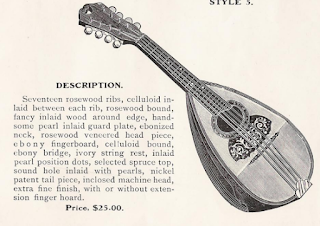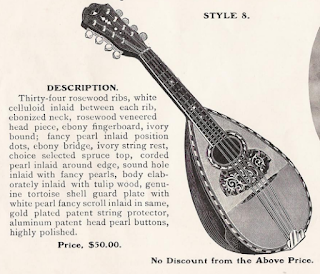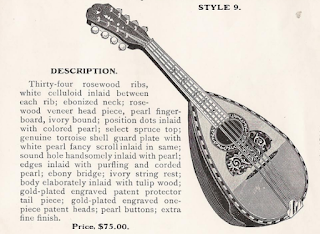Harry J. Flower & The MayFlower Music Company
Harry J. Flower was born in 1862 in Poland to Solomon and Rosa Flower and immigrated to the United States in 1868. He later married his wife Minnie who was three years his younger. They had two children, Edgar H. Flower (b. 1890, d.?) and May Flower (b.1895, d.?). The latter child would become the namesake of his company. In the 1900 census, Harry was listed as a "music dealer" [2].
The history of his company is difficult to understand due to their relatively small presence in a city dominated by musical instrument manufacturing giants. One of the big questions is whether May Flower was a distributor of instruments built by other manufacturers or if they actually build their own. Gregg Miner of HarpGuitars.net has the most in-depth research on the company, with a focus on their harp instruments, and the purpose of my article is to expand on what he has discovered.
The name appears as MayFlower, Mayflower, and May Flower in various documents which makes research confusing.
Andrew Groehsl
Early instruments include "Flower & Groehsl, manufacturers" which is a key clue. Groehsl more than likely refers to Andrew Groehsl (also written as Groeshel and Groeschel, confusingly) (b. 1860, d.?) who is more well known for founding his own instrument company that became Stromberg-Voisinet and later the Kay Musical Instrument Company.
Information about Groehsl is, unfortunately, sparse and I'm unable to discern where his company was located and where an early factory would've been.
 |
| Label from an early Mayflower Guitar (#10614) Image Credit: Instagram - Chuck Sanzone |
Larson Brothers
Update: 12/22/25: The Larson Brothers name often comes up when May Flower instruments are discussed and as I've become more knowledgeable and had my hands on more instruments, I've come to a slightly controversial conclusion. I don't believe that the Larson Brothers had their hands in the construction of 6 string May Flower guitars. I haven't had my hands on a Larson Bros or May Flower mandolin or harp guitar but.
My reasoning is two-fold.
- The May Flower guitars that I have had in my hands, the ones I've worked on, and the examples I've seen online simply do not match enough of the design principles from the Larsons. There are similarities, such as the volute carve, but those are just one piece in a puzzle of clues to identify a builder.
- There is a hesitancy in the guitar collecting world to attribute an intricate instrument to the unnamed craftsman working at a manufacturing firm. It's a far better story, and easier sell, when we can imagine the two elusive, Swedish brothers working on guitars by candlelight. The reality is that they were not craftsman with skills beyond the abilities of their time but two of many talented builders in Chicago
If a May Flower guitar surfaces with any of the patented Larson designs, I'll change my tune because that is irrefutable. Until then, I will continue to attribute May Flower instruments to Andrew Groehsl and his workers as the historic record shows.
Timeline
1896
Harry Flower owned a pawnshop at 86 West Madison St [13].
1898
Registration is issued for the May Flower Mandolin and ads begin appearing in local papers.
| Official Gazette of the United States Patent Office Vol 85 Image Credit
|
1900
Employee, Harry Levy, was arrested for embezzling nearly $1000 from Harry Flower. The address is listed as 86-88 West Madison St
 |
| Music Trade Review 1900 - Image Credit |
1902
The 1902 Annual Report of the Factory Inspectors of Illinois report has their location at 210 State St and lists 4 employees with 3 being "males over 16 years" and 1 "boys under 16 years" (likely his son Edgar) [3]. An entry in Proceedings of the City Council from the same year lists an issued permit for a 3 foot by 10 foot electric sign for the May Flower Music Company at their 210 State Street location [6]
This advertisement credits the May Flower mandolins to Italian luthier Antone Vallette who has them imported to the US through Harry Flower distributed by, at least, Oliver Ditson & Co
 |
| Music Trade Review 1902 - Image Credit |
1904
The May Flower Music Company adds "Joseph W. Stern and Co" as a New York dealer for their instruments. It also mentions that Oliver Ditson's company distributed May Flower mandolins before Ditson was acquired by Lyon and Healy.
 |
| Music Trade Review 1904 - Image Credit |
1905
 |
| Music Trade Review 1905 - Image Credit |
1906
The 1906 report lists their location at 272 State St with 3 employees with 1 "females over 16 years" and 2 "males over 16 years". There is new column entitled "Do they manufacture" which has a "Yes" [4].
1907
 |
| "Joliet Evening Herald" advertisement from a dealer of Mayflower instruments Image Credit |
1908
The Rudolph Wurlitzer Company acquires the "guitar and mandolin" factory of Harry Flower who was retiring from the business. This is the most important article I have found as it confirms the theory that at least some May Flower instruments were built in-house.
It states that Harry Flower owned his own factory for producing guitars and mandolins and claimed an output of "a thousand Mayflower banjos and guitars annually" as well as an undisclosed amount of mandolins.
 |
| Music Trade Review 1908 - Image Credit |
1910
The 1910 census lists Harry J. Flower as being a jeweler at a retail store.
1911
The 1911 Annual Report of the Factory Inspectors of Illinois report lists the location at 195 Wabash Ave with two employees. Both employees are males over the age of 16 years [5]. Its unclear what business they were still conducting
1913
In the 1913, Certified List of Domestic and Foreign Corporations Filed with the Recorder of Deeds, Harry J. Flower is listed as the owner of the Howard Jewelry Company at 326 S. State St with Frank B. Flower as his secretary.
1914
Harry J. Flower dies at the age of 52 [12]
1915
Harry's daughter, May Flower, marries Arthur J. Shutan and they go on to have one son, Robert Harry Shutan (b.1919, d.2008) [11][14]
Models
Sizing
The May Flower literature that survives has each guitar model offered in three sizees (standard, concert, and grand concert) with no specifics as to their measurements. The guitar that I owned, #11186, was stamped "CON" on the neck block which could reasonably be interpreted as "Concert".
Standard Dimensions:
unknown
Concert Dimensions:
Upper Bout: 9-1/2”
Lower Bout: 13-1/2”
Body Thickness: 3-3/8” to 3-1/8”
Nut Width: 1-3/4”
Scale Length: 24-15/16”
Grand Concert Dimensions:
unknown
1901-02 (approx) Catalog
There only exists one catalog scan of an early Mayflower catalog which can be found here and I have uploaded a mirror here. I believe the uploader is James Garber and so all credit goes to him for the excellent find and scanning. Gregg Miner deduces that the testimonies are all dated to 1901 which would reasonably put the catalog at 1901-1902.
Style 201 (and I'm going to assume 202 and 203 are the other sizes). These guitars are Brazilian Rosewood with pearl inlays around the edge, a fancy wood back strip on the board, bound Ebony finger board with pearl position dots, and an Ebony bridge.
Mandolins
 |
| Harrington Special Named for mandolin player H. Scott Harrington |
 |
| Style 4 |
 |
| Style 5 |
 |
| Style 6 |
 |
| Style 7 |
 |
| Style 8 |
 |
| Style 9 |
 |
| Style 10 |
 |
| Style A |
post-1908 (approx) Catalog
Update as of 12/22/25: I stumbled across this while searching for different brand of instruments distributed by the Wurlitzer company. This isn't a stand-alone May Flower catalog but is incorporated within the normal Wurlitzer offerings so we don't have true model numbers but rather catalog designations. The catalog isn't dated (it is marked issue #71) but since Wurlitzer purchased the May flower facilities in 1908, it would have to be after that date. There is another, undated, catalog (#97) that does not feature any May Flower branded guitars.
This catalog comes from the Cincinnati Public Library's digital collections
Guitars
The 9205, 9206, and 9207 are the most plain of the offered instruments and are probably similar to the Style 1 from the previous catalog.
The 9305, 9306, and 9307 models feature pearl purfling and a pearl rosette which would be similar to the Style 2 from the previous catalog.
The 92__ and 93__ models were also offered in a Venetian headstock (often called the Stauffer or 'slipper foot' headstock) for $10 more. I've seen a couple of these on the internet and wondered how they fit into the timeline of the May Flower instruments.
The 94__ line isn't pictured in it's normal configuration, there is an illustration of a "-V" venetian headstock variant but that is under the description of the 95__ series and has far more pearl than the above description. I'm convinced either a drawing is mislabeled or the catalog numbers got jumbled.
The most expensive offering is the 95__ series but you'll note that the description appears to match the illustration labelled "9405-V" rather than the "9505" illustration. I suppose that was an error as these instruments are quite different.
This is the most elaborate of the offerings with a wild display of pearl, select woods, and other endangered materials.
Mandolins
Bracing
These bracing pictures were taken from #11186 and show a unique "H' bracing pattern kinda like what an old Gibson L-1 would have except more parallel. The braces are tucked into each other and show a high quality of workmanship. The instrument has a small spruce bridge plate) and white linen reinforcements on the top seam. The sides have a black linen reinforcement. The laminate back is very lightly braced with three low transverse braces.
I compared and contrasted with Chuck Sanzone who owns #10614 and we both found that our bracing patterns are identical and the bodies were extremely resonant when tapped.
I have owned a few 30s Kay guitars that have had a very similar bracing, likely a remnant from the Groehsl era
Extant Examples
Style 102 - Concert size
Serial: #10614
Images from Reverb - Guitar Showcase
Style 9306 - Concert size
Serial: #11186Image Credit: Myself
Upper Bout: 9-1/2”
Lower Bout: 13-1/2”
Body Thickness: 3-3/8” to 3-1/8”
Nut Width: 1-3/4”
Scale Length: 24-15/16”
Update 12/22/25: After the reveal of the Wurlitzer catalog, I believe this to be a 9306 model instrument.
One interesting quality about this guitar is the back is a 3-ply laminate made entirely of brazilian rosewood. The center strip is inserted with the top-most laminate which would not have required any routing.
Style 930x?
Serial: #?Image Credit: Worthpoint archive of an Ebay listing
Update 12/22/25: Due to the reveal of the Wurlitzer catalog, I feel safe in saying that this guitar was part of the 9300 series of instruments. As the size isn't known, it could be a 9305, 9306, or 9307.
The bridge, having the pearl inlay, should've only been in the 9400 series but I will point out that the bridge inlay looks identical to what I have on an 1890s Lyon and Healy. There is a possibility that this bridge is not original to the guitar as I know L&H carved their own pearl.
Attributed to the Larson brothers by seller, claim is dubious.
Style 9506-V
Serial: #?Image Credit: Reverb - Tone Network Music
Lower Bout: 13”
Nut Width: 2”
Scale Length: 24.9”
Update 12/22/25: Due to the reveal of the Wurlitzer catalog, I'm confident that this is a model 9506-V. The provided dimensions matches my concert-sized guitar, the appointments fit in the 9500 series, and the Venetian headstock would be designated as such.
Stauffer style headstock with pearl vine inlays and pearl bound top. Attributed to the Larson Brothers by seller, claim is dubious.
Sources
[1] http://www.harpguitars.net/history/mayflower/mayflower.htm
[2] https://www.familysearch.org/ark:/61903/3:1:S3HT-68NQ-ZHQ?i=4&cc=1325221&personaUrl=%2Fark%3A%2F61903%2F1%3A1%3AMS36-NLH
[3] https://books.google.com/books?id=fvZZAAAAYAAJ&dq=%22may+flower+music+co%22&q=may+flower#v=snippet&q=may%20flower&f=false
[4] https://books.google.com/books?id=B9FJAQAAMAAJ&pg=PA604&dq=%22may+flower+music+co%22&hl=en&newbks=1&newbks_redir=0&sa=X&ved=2ahUKEwiC8Ljs5tfsAhVNZM0KHck0DewQ6AEwA3oECAIQAg#v=onepage&q=%22may%20flower%20music%20co%22&f=false
[5] https://books.google.com/books?id=fP1ZAAAAYAAJ&pg=PA309&dq=%22may+flower+music+co%22&hl=en&newbks=1&newbks_redir=0&sa=X&ved=2ahUKEwiC8Ljs5tfsAhVNZM0KHck0DewQ6AEwAHoECAMQAg#v=onepage&q=%22may%20flower%20music%20co%22&f=false
[6] https://books.google.com/books?id=rLMVAAAAYAAJ&pg=PA1721&dq=%22may+flower+music+co%22&hl=en&newbks=1&newbks_redir=0&sa=X&ved=2ahUKEwiC8Ljs5tfsAhVNZM0KHck0DewQ6AEwBXoECAYQAg#v=onepage&q&f=false
[8] https://books.google.com/books?id=a2Q9AQAAMAAJ&pg=PA208&dq=%22harry+j+flower%22&hl=en&newbks=1&newbks_redir=0&sa=X&ved=2ahUKEwjht9Wy6tfsAhWUBs0KHTdvCnYQ6AEwBHoECAQQAg#v=onepage&q=%22harry%20j%20flower%22&f=false
[9] https://books.google.com/books?id=UZJRAQAAMAAJ&pg=RA1-PA941&dq=harry+j+flower&hl=en&newbks=1&newbks_redir=0&sa=X&ved=2ahUKEwjbp8CD6tfsAhXMQs0KHT4KB-0Q6AEwAnoECAYQAg#v=onepage&q=harry%20j%20flower&f=false
[10] https://www.familysearch.org/ark:/61903/3:1:33SQ-GRV5-SJ6?i=7&cc=1727033&personaUrl=%2Fark%3A%2F61903%2F1%3A1%3AMKCQ-13W
[11] https://books.google.com/books?id=s1ccAQAAMAAJ&pg=PA402&dq=harry+j+flower&hl=en&newbks=1&newbks_redir=0&sa=X&ved=2ahUKEwjbp8CD6tfsAhXMQs0KHT4KB-0Q6AEwBnoECAcQAg#v=onepage&q=harry%20j%20flower&f=false
[12] https://www.familysearch.org/ark:/61903/1:1:Q2MQ-LWLL
[13] https://www.newspapers.com/image/33859200/?terms=harry%2Bflower
[14] https://www.familysearch.org/ark:/61903/3:1:33SQ-GR46-GXR?i=46&cc=1810731&personaUrl=%2Fark%3A%2F61903%2F1%3A1%3AXSTW-S76


















































No comments: